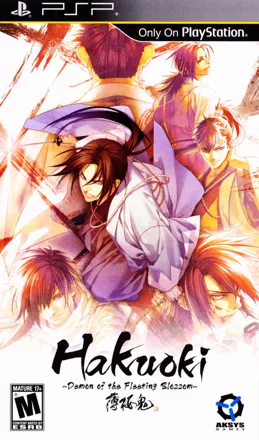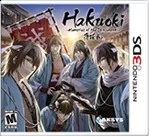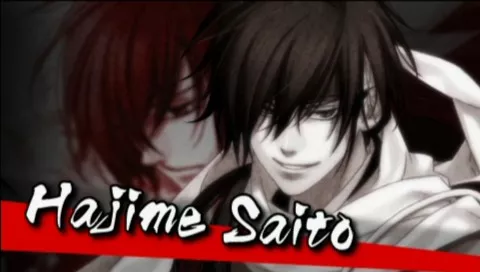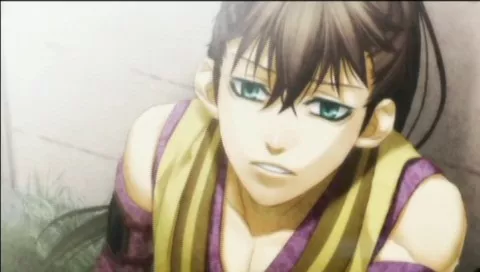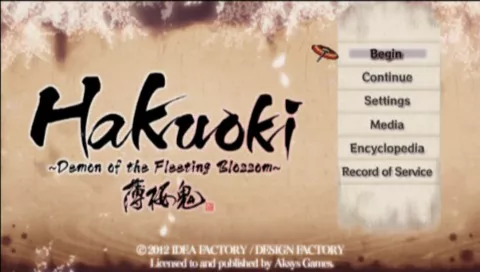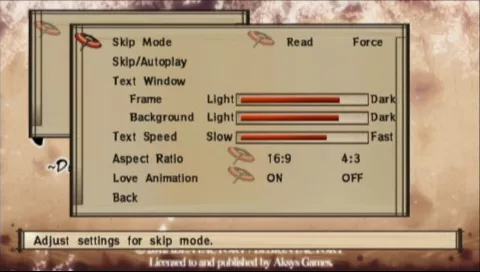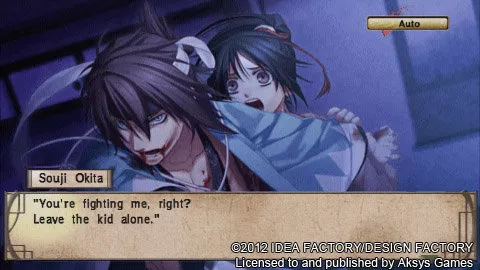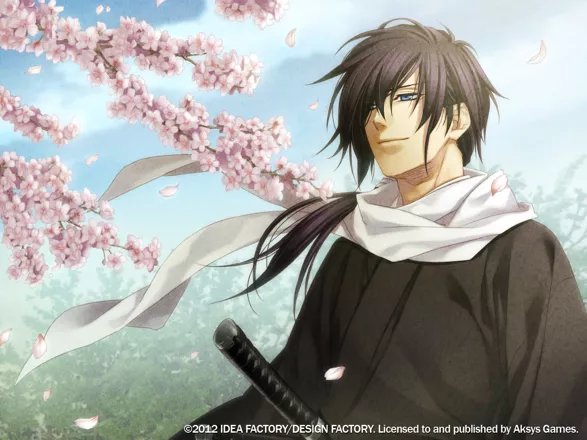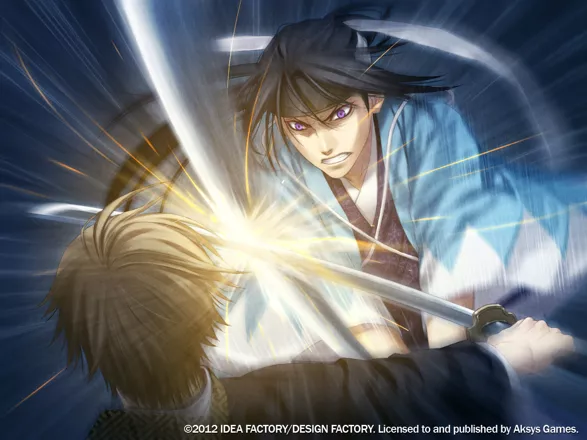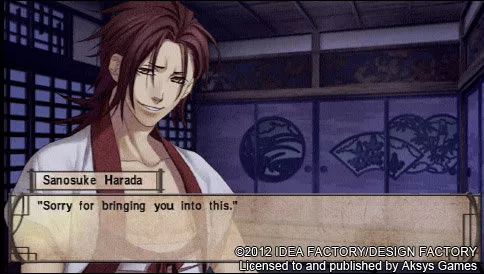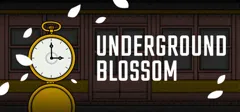Hakuoki: Demon of the Fleeting Blossom
Description
Hakuoki: Demon of the Fleeting Blossom is a visual novel that follows the story of a young woman by the name of Chizuru who is searching for her missing father. Set around the end of Edo period when samurai warriors are becoming a remnants of a past era. While not being a downright love simulation, the game lets you pursue a relationship with some of the male characters. As such, the game was released on Valentine's Day and is focused more towards the female audience. As many games of its genre, it also features multiple endings based on choices you make throughout the story.
Groups +
Screenshots
Promos
Credits (PlayStation 2 version)
90 People · View all
| Presented by |
|
| Toshizō Hijikata (土方 歳三) |
|
| Sōji Okita (沖田 総司) |
|
| Hajime Saitō (斎藤 一) |
|
| Heisuke Tōdō (藤堂 平助) |
|
| Sanosuke Harada (原田 左之助) |
|
| Isami Kondō (近藤 勇) |
|
| Kensuke Sannan (山南 敬助) |
|
| Shinpachi Nagakura (永倉 新八) |
|
| Genzaburō Inoue (井上 源三郎) |
|
| Susumu Yamazaki (山崎 烝) |
|
| Kai Shimada (島田 魁) |
|
| Kashitarō Itō (伊東 甲子太郎) |
|
| Chikage Kazama (風間 千景) |
|
| Kaoru Nagumo (南雲 薫) |
|
| Kyō Shiranui (不知火 匡) |
|
| Kyūju Amagiri (天霧 九寿) |
|
| Ryōjun Matsumoto (松本 良順) |
|
| Takeaki Enomoto (榎本 武揚) |
|
| Keisuke Ōtori (大鳥 圭介) |
|
| Kōdō Yukimura (雪村 綱道) |
|
| Senhime (千姫) |
|
| Kimigiku (君菊) |
|
| Soldiers, etc. (隊士役等) |
|
| [ full credits ] | |
Reviews
Critics
Average score: 75% (based on 9 ratings)
Players
Average score: 4.7 out of 5 (based on 2 ratings with 1 reviews)
A story of adventure, romance, and tragedy that's worth a look.
The Good
Because of all of the mystery surrounding the setting of Hakuoki, this kind of visual novel takes the idea of “routes” to a different level than, say, Katawa Shoujo. Unlike the latter which lets you play through each story to learn about each girl, Hakuoki makes you play through each route not only to learn about each guy, but also to uncover the full mystery behind the current happenings. To learn more about Sen, her ninja bodyguard/friend, and the smart-looking but dangerous Keisuke Sanan, you’d play through Heisuke Toudou’s route. However, this same route doesn’t reveal what exactly happened to your father - you’d have to play a different route for that. There’s also a situation with a character that looks strikingly similar to our heroine (?), Chizuru Yukimura. Want to learn more about what’s up with that? Well, too bad - Heisuke’s route will give you a little hint into the situation (as will all others), but only Okita’s route unlocks the mystery of the lookalike. You’d expect a layout like this to be irritating, but I find it a welcome addition that works to get you playing through every single route and satisfactorily finding a piece of the puzzle throughout each one. This includes the history of Amagiri and Shiranui, big bad Kazama’s lackeys. Expect to find tragedy in places you don’t always see coming. Remember: play through each route to get the full picture. Otherwise, you’re not playing the game right.
Additionally, the route of the aforementioned villain of the game can be unlocked by going through other routes. That’s right - you get to see the story of Hakuoki through a villain’s perspective. Sounds like fun.
But of course, this game isn't all about the romance. For those of you who are fans of the shogun/samurai era (more commonly referred to as the Sengoku period) - and there are probably quite a few of you judging from the love franchises such as Samurai Warriors and Sengoku Basara get - Hakuoki goes well into detail about specific events of the Edo period in which it takes place. Additionally, these specific events, including the switch of rulers among other happenings you’d find in a history textbook, impact the characters of the story indirectly. Considering the men of the Shinsengumi were real-life people, you know the information you’re getting here, if not a bit skewed by Chizuru and the anime-like personalities given to these men by the developers, is reliable enough to impress with this all-too-great, obscure Japanese knowledge. By the time the game reaches the Meiji Restoration, the Shinsengumi, formerly of strict service to the shogunate, begins to fall apart. Now that the shogun is no longer in power, the Shinsengumi and samurai are becoming obsolete. While the restorations of Emperor Meiji are viewed by the West as a great turn of events for the formerly isolated country, the real tragedy behind it can be seen in the stories of these soldiers.
Alas, the great attention to detail put into the history of Hakuoki makes for some dramatic twists beyond our cackling baddies and budding romantic feelings. I find the accuracy of Japanese history Idea Factory put into Hakuoki very impressive, right down to the glossary entry you obtain on the historical event right after each one occurs. On a side note, another interesting tidbit I’d like to add is the mention of the “Western demons” - counterparts to the Japanese brethren we find lurking around Hakuoki. Western demons are significantly worse than Eastern demons in every way (obviously), but perhaps it’s only because Bram Stoker portrayed Western “demons” as monsters who suck blood while the good people at Idea Factory decided they wanted Japanese demons to surpass the Western idea of monsters by giving them crazy awesome powers and making them ultimate badasses, while not daring to tarnish the name of monsters (I’m sorry, demons) as they are portrayed in the West. I think I’d do that, too. Score one for Japanese nationalism and their badass demons.
Another cool thing is that Japanese voice acting is used in the localization of Hakuoki as well; every single scene is voice acted, and the voice actors (my personal favorites being those of Heisuke and Okita) do a fantastic job bringing emotion into their roles, making the scenes that much more enjoyable.
The Bad
I really don’t have much to say here. However, there are a few things that Idea Factory could have done better in this historic visual novel. First of all, (and this was to be expected) Chizuru Yukimura has too much of a back seat in the story. She’s always on the sidelines, listening as the men of the Shinsengumi deliberate or fight to the death. Sure she has a sword, but she never really uses it against enemies. Though we do get a breath of fresh air in Hijikata’s route (where Chizuru displays anger toward Kazama in the place of fear for the sake of a fallen comrade) and Aksys did their best to make Chizuru more likable and less...er...stupid, Hakuoki falls short of giving the protagonist a bigger role in the story as games such as La storia della Arcana Famiglia have.
I have one other gripe with this game, and this may seem stupid, but it really did bother me; this was not being able to pursue a relationship with Nagakura Shinpachi. He's included in a ton of promotional artwork, and Idea Factory at least could have included a new route for the game's release in Japan (as a portable version of the original Hakuoki). Nagakura's silliness would have made for a nice balance among the tragedy encountered throughout the story of Hakuoki. The lack of otherwise new content makes for an experience that doesn't offer much else for people who picked up and played Hakuoki on the PlayStation 2.
The Bottom Line
Visual novels generally aren’t popular among Western gamers – even Western audiences in general. Categorized in the adventure game genre, visual novels play out as the Choose Your Own Adventure books you’d read as a kid. Make choices that affect the ending of the story – the earlier the branches start, the more time can be spent absorbed in the world of this visual novel – or, more simply, more replay value. For those gamers who have already delved deep into the world of visual novels, whether it be due to their understanding of Japanese or their embracement of personal computer games, this is nothing new. However, for that small percentage of girl gamers that have been longing for a translated visual novel that isn’t Yo-Jin-Bo, Aksys Games has sent North American otome fans something of a blessing with their latest choice for localization: Hakuoki: Demon of the Fleeting Blossom.
One look at games like Tokimeki Memorial: Girl's Side, Dual Love, and even the Prince of Tennis visual novel game released for the Nintendo DS would make male gamers scoff. Whether it’s due to the interactivity or the largely unrealistic male personalities, it’s enough to fulfill a girl’s wildest Japanese fantasy. Luckily, as long as we’re not looking at the likes of yaoi, there really is nothing to fear for a straight guy playing a girl’s visual novel. Absent are the pornographic scenes found in the typical male visual novel and in are the rather sappy but heart-warming story elements that tug at heartstrings you didn’t even know existed. Though guys may not be so comfortable playing Tennis no Oujisama: Girls Be Gracious, that Prince of Tennis visual novel I mentioned earlier, I can assure you that Hakuoki: Demon of the Fleeting Blossom is a safe choice with enough action and adventure to give the romance a back seat.
PSP · by Masa♥Yuki (3073) · 2012
Analytics
Identifiers +
Contribute
Are you familiar with this game? Help document and preserve this entry in video game history! If your contribution is approved, you will earn points and be credited as a contributor.
Contributors to this Entry
Game added by MAT.
PlayStation 2 added by Alaka.
Game added April 2, 2012. Last modified February 9, 2025.


